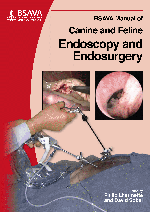
Full text loading...

PLEASE NOTE THAT A MORE RECENT EDITION OF THIS TITLE IS AVAILABLE IN THE LIBRARY
Ear disease is one of the most commonest conditions affecting dogs and cats. Otitis externa (OE) is one of the most common and challenging ear diseases encountered, particularly in the dog. In dogs chronic inflammation of the ear canal is frequently associated with an extension of inflammation to deeper structures of the ear, resulting in otitis media (OM) or, less commonly, otitis interna (OI). Feline OE is less prevalent and rarely progresses to OM. More commonly, feline OM is the consequence of aetiological factors that directly affect the middle ear (e.g. inflammatory polyps, neoplasia, infection from the upper respiratory tract). The first diagnostic procedure that must be performed on a patient with suspected ear disease is an otoscopic examination. This chapter examines Indications; Instrumentation; Patient preparation; Preoperative diagnostic work-up; Procedure; Normal findings; Pathological conditions; Postoperative care; and Complications.
Rigid endoscopy: otoendoscopy, Page 1 of 1
< Previous page | Next page > /docserver/preview/fulltext/10.22233/9781905319572/9781905319572.9-1.gif

Full text loading...

















